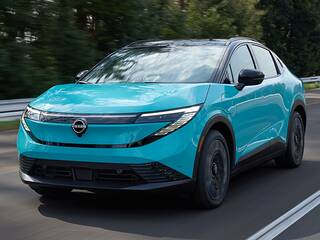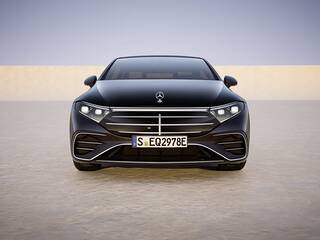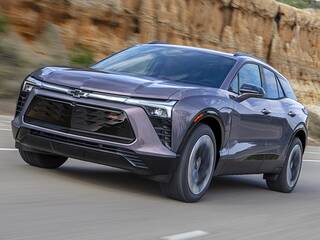Here's why this Toyota hybrid is the most disappointing engine of 2025
Hybrids are supposed to win handily at fuel economy and maybe acceleration, too. But Toyota has built a hybrid powertrain that does neither, and it doesn't come cheap.

published Feb 15, 2025 | updated Feb 16, 2025

Key Takeaways
- The 2.4-liter i-Force Max hybrid engine powers multiple key models in Toyota's lineup.
- Its horsepower and torque numbers look great on paper.
- The acceleration and fuel economy it actually delivers are a very different story.
A lot of people were excited about Toyota's truck-specific version of the 2.4-liter i-Force Max hybrid powertrain when it was announced, myself included. The numbers were, and still are, quite juicy:
326 horsepower. 465 pound-feet of torque.
The four-cylinder i-Force Max promised to bring unprecedented oomph to the reinvented Land Cruiser, as well as the all-new 4Runner Hybrid and Tacoma Hybrid. And early impressions seemed to confirm it.
To wit:
"[The Land Cruiser's] abundant torque was on full display as we barreled up freeway off-ramps....We expect the new Cruiser to be a few tenths behind the 6.2-second 60-mph acceleration time we measured on the [V6-powered Lexus] GX 550."—Car and Driver
"Weighing 800 pounds less than the [previous-generation] 200 Series and blessed with...on-demand torque, the new Land Cruiser feels considerably quicker. We think the 0-60-mph time will drop by nearly a second."—MotorTrend
"[T]he new Land Cruiser feels much quicker than the SUV it replaces — we estimate a 0-60 mph time of around 6.4 seconds."—Edmunds
That's a lot of enthusiasm early in the game. But what would happen when the same outlets actually tested this fancy new powertrain?
And how would its fuel economy shake out compared to non-hybrid rivals?
Acceleration testing: Womp, womp
Doubts about the i-Force Max started to take root when the third-party Land Cruiser test results came in.
MotorTrend clocked it at 8.0 seconds to 60 mph, 1.2 seconds slower than the previous Land Cruiser V8's 6.8-second sprint, whereas the initial review anticipated an improvement of "nearly a second." That is, they thought it would do the deed in about 6 seconds flat.
Car and Driver reported a 7.7-second gallop, a full second off the previous Cruiser's pace in their testing — and more than a second slower than C/D's projection of 6.5 seconds or so.
And Edmunds could only manage an 8.2-second run, deeming the LC's acceleration "decidedly lackluster." If you're scoring at home, that's 1.8 seconds slower than their 6.4-second estimate.
Summing up, the three outlets foresaw times ranging from 6.0 to 6.5 seconds based on early-access quick spins, but when they hooked up their equipment, they observed 7.7 to 8.2 seconds.
Ouch.

The news isn't much better on the Tacoma front. As we reported, Car and Driver timed a non-hybrid, automatic-transmission Tacoma TRD Off-Road at 7.0 seconds to 60 and 15.3 seconds at 91 mph in the quarter-mile.
MotorTrend, meanwhile, got a 7.1-second sprint out of a Tacoma TRD Off-Road Hybrid, hitting the quarter in 15.4 seconds at 88 mph.
So, despite enjoying a 48-horsepower advantage and making 148 more pound-feet of torque than its non-hybrid sibling, the Tacoma TRD Off-Road Hybrid was a tick slower to 60 and a substantial 3 mph off the quarter-mile pace.
The 4Runner Hybrid hadn't been tested as of this writing, but there's no reason to expect more encouraging results. Its output numbers are exactly the same: 326 hp, 465 lb-ft.
As for the competition, we need look no further than Ford. The Tacoma Hybrid contends with the Ranger V6, which zips to 60 mph in 5.6 seconds, while the Land Cruiser has to think about the Bronco V6, which hits 60 in 6.2 seconds.
That's despite the fact that the Ranger's 2.7-liter turbo V6 is rated at 315 hp and 400 lb-ft — 11 hp and 65 lb-ft less than the i-Force Max — while the Bronco's version of the same engine is rated at 330 hp and 415 lb-ft.
The Toyotas should be fully competitive with these Fords based on the numbers.
Instead, the Blue Oval blows them into the weeds.
Fuel economy: Not great
You might theorize that Toyota's hybrid-powered horses are less robust because fuel economy is on their minds, but you'd be mostly mistaken. Take a look — the Tacoma TRD Off-Road Hybrid is rated at 23 mpg combined, while the non-hybrid TRD Off-Road checks in at 21 mpg combined.
All else being equal, no one's going to turn down an extra 2 mpg, but remember, the Tacoma Hybrid is actually slower despite its huge output advantage.
So in the Tacoma's case, the proposition is, pay a premium — at least $5-6k more, depending on the trims you're comparing — for slightly better fuel economy and worse acceleration.
The previous-generation Tacoma V6 4WD, by the way, was rated as high as 20 mpg combined, so again, we're talking incremental gains despite all that fancy hybrid technology.

The Land Cruiser, for its part, is far more fuel-efficient than the previous V8-powered model, which was rated at 14 mpg combined before it retired. The hybrid LC is rated at 23 mpg combined, same as most versions of the Tacoma Hybrid.
But that's a low bar, obviously, and the venerable V8 compensated with significantly better acceleration, as noted above. Compared to the Bronco V6, which is rated at 20 mpg combined, the Land Cruiser looks less frugal. On the one hand, yes, 23 mpg is 15 percent better than 20. But the hybrid Cruiser's acceleration is about 25 percent worse, and its starting price is roughly 17 percent higher.
Which would you rather have in your fancy 4x4 — superior acceleration at a lower price, or an extra 3 mpg?
Is this the most disappointing engine of 2025?
I'd turn that question around and say:
Tell me why it's not.
Toyota had a real opportunity here to deliver mind-blowing fuel economy by off-roader standards, and that seems to have been the internal expectation, as evidenced by the automaker's initial claims of 27 mpg for the Land Cruiser.
But something funny happened on the way to the EPA, and now we're talking 23 mpg for all of these hybrid Toyota rigs, which surely isn't enough to move the needle for most off-road enthusiasts.
Even so, the i-Force Max could have lived up to its gaudy output numbers in the acceleration column and at least matched those V6 Fords. Instead, it can't even match the non-hybrid version of the same engine.
I doubt there's another engine in 2025 that misses its marks so thoroughly, especially one that's positioned as an upgrade. The 2.4-liter i-Force Max fails to impress in the areas that matter most, and that's not good news for an engine that's supposed to convince people to part with more cash. ⛐ md

by Josh Sadlier
Publisher and Donkey-in-Chief
Josh has been reviewing cars professionally since joining Edmunds.com fresh out of grad school in 2008. Prior to founding MotorDonkey, he spent 15 years shaping Edmunds' expert automotive content in various capacities, starting as an associate editor and ultimately serving as a senior editor before wrapping up with a five-year term as the company's first-ever director of content strategy. Josh is a card-carrying member of the Motor Press Guild and a lifelong car nut who has driven, compared and critiqued thousands of cars in his career. Helping people find their perfect car never gets old—seriously!
 Let's make it official!
Let's make it official!
Be a good donkey and we'll deliver delicious car news straight to your inbox, spam-free forever.


